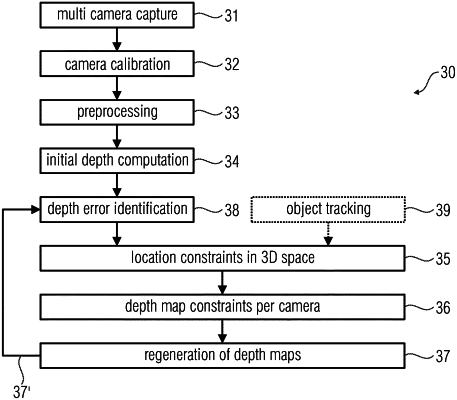| CPC G06T 7/50 (2017.01) [G06F 18/214 (2023.01); G06T 7/70 (2017.01); G06T 15/04 (2013.01); G06T 15/08 (2013.01); G06V 20/647 (2022.01); G06V 20/653 (2022.01); G06T 2207/20092 (2013.01)] | 13 Claims |

|
1. A method for localizing, in a space comprising at least one determined object, an object element associated to a particular 2D representation element in a determined 2D image of the space, the method comprising:
deriving a range or interval of candidate spatial positions for the imaged object element on the basis of predefined positional relationships;
restricting the range or interval of candidate spatial positions to at least one restricted range or interval of admissible candidate spatial positions, wherein restricting comprises defining at least one surface approximation, so as to limit the at least one range or interval of candidate spatial positions to a restricted range or interval of candidate spatial positions;
considering a normal vector of the surface approximation located at the intersection between the surface approximation and the range or interval of candidate spatial positions;
retrieving, among the admissible candidate spatial positions of the restricted range or interval, a most appropriate candidate spatial position on the basis of similarity metrics, wherein retrieving comprises retrieving, among the admissible candidate spatial positions of the restricted range or interval and on the basis of the normal vector, a most appropriate candidate spatial position on the basis of similarity metrics involving the normal vector,
wherein
retrieving comprises processing similarity metrics for at least one candidate spatial position for the particular 2D representation element,
wherein processing involves further 2D representation elements within a particular neighborhood of the particular 2D representation element,
wherein processing comprises acquiring a vector n among a plurality of vectors within a predetermined range defined from vector n0, to derive a candidate spatial position, associated to vector n, for each of the other 2D representation elements, under the assumption of a planar surface of the object in the object element, wherein the candidate spatial position is used to determine the contribution of each of the 2D representation elements, in the neighborhood to the similarity metrics.
|